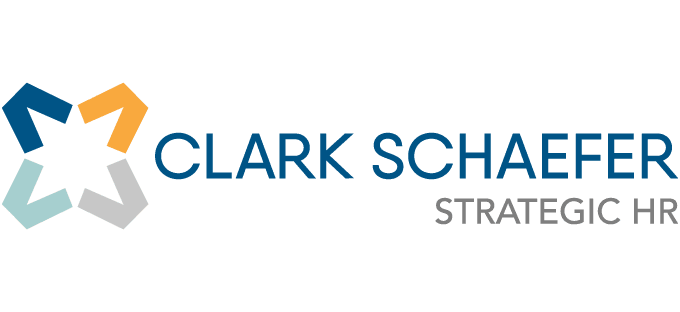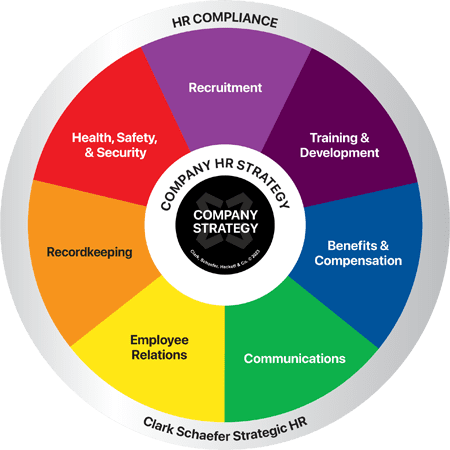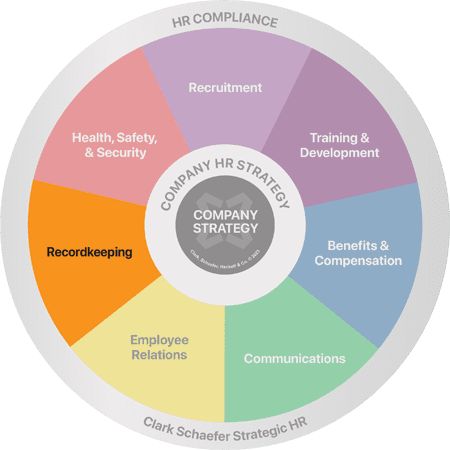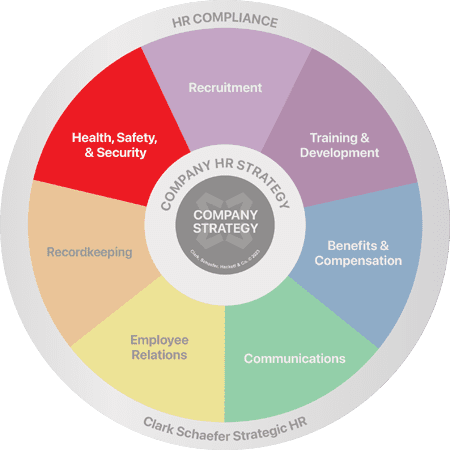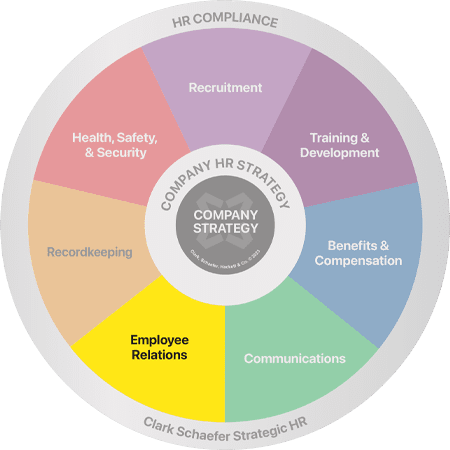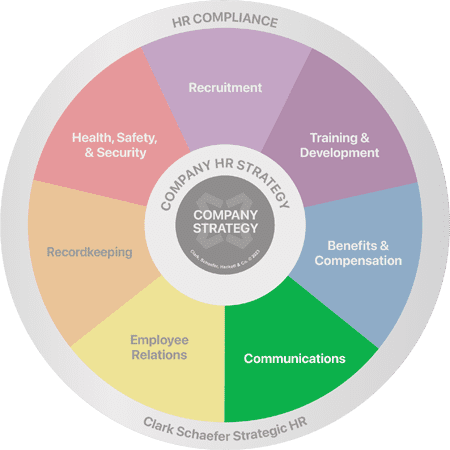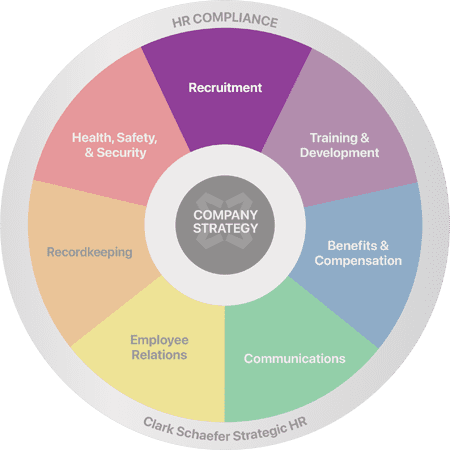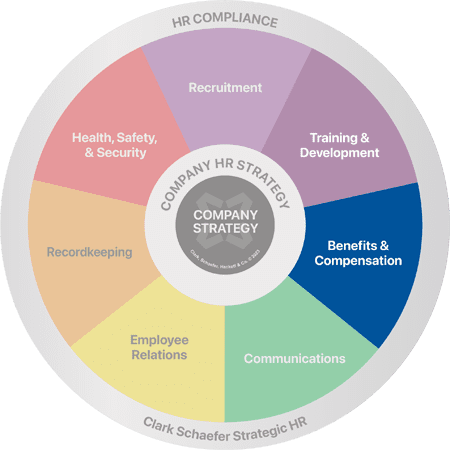HR Compliance Questions of the Week
What Employers Need To Know About Michigan’s Earned Sick Time Act (ESTA)
Publishedin Benefits & Compensation, HR Compliance

HR Question:
Our company has locations in multiple states, including Michigan, where there’s been a recent change to the Earned Sick Time Act. Can you explain what’s changed and what we, as an employer, need to do to comply with Michigan’s Earned Sick Time Act?
HR Answer:
Yes, this has been an evolving issue. On February 21, 2025, Michigan Governor Gretchen Whitmer signed House Bill 4002 into law, amending the state’s Earned Sick Time Act (ESTA). These changes have significant implications for employers operating within Michigan as they include revisions to accrual rates, carryover rules, and compliance deadlines. Below we’ll outline what Michigan employers should consider moving forward to support their compliance.
Key Provisions of House Bill 4002
House Bill 4002 introduces several critical modifications to the ESTA, including the following four key components:
1. Accrual and Usage of Earned Sick Time
For employers with 10 or fewer employees:
Employees accrue one hour of paid earned sick time for every 30 hours worked, up to a maximum usage of 40 hours per year. Employers have the option to provide 40 hours of paid sick time at the beginning of the year, allowing immediate use.
For employers with more than 10 employees:
Employees accrue one hour of paid earned sick time for every 30 hours worked, with a maximum usage of 72 hours annually. Alternatively, employers can frontload 72 hours of paid sick time at the start of the year.
2. Carryover Provisions
For employers with 10 or fewer employees:
Employees may carry over up to 40 hours of unused earned sick time to the following year.
For employers with more than 10 employees:
Employees can carry over up to 72 hours of unused earned sick time annually.
3. Frontloading Option
Employers choosing to frontload the full allotment of sick time at the year’s start are not required to track accruals or allow carryover of unused time.
4. Effective Dates
The amendments took immediate effect on February 21, 2025. However, small employers with 10 or fewer employees have until October 1, 2025, to comply with the paid earned sick time provisions.
Implications for Employers
Employers in Michigan must assess and adjust their policies to align with the revised ESTA requirements. As you work to support your compliance, consider the following:
- Policy Review and Update: Examine existing leave policies to ensure they meet or exceed the new standards. This may involve revising accrual rates, usage caps, and carryover rules.
- Record-Keeping Practices: Implement systems to accurately track hours worked, sick time accrued, and sick time used. For employers opting to frontload sick time, be sure to have clear documentation of the provided hours and any usage.
- Employee Communication: Inform staff about their rights and responsibilities under the updated sick leave policy. Clear communication helps prevent misunderstandings and ensures employees are aware of how to utilize their earned sick time.
- Budget Considerations: Anticipate the financial impact of providing additional paid sick time, which is especially critical for smaller businesses with limited resources. Planning ahead can help mitigate potential budgetary constraints.
- Compliance Timeline: While the law is already in effect, small employers have until October 1, 2025, to implement the necessary changes. It’s crucial to use this time effectively to be better positioned to comply by the deadline.
Supporting Your Organization’s Compliance
To navigate these changes successfully, we encourage employers to:
- Consult Legal Counsel: Seek advice to understand the specific implications of House Bill 4002 on your organization and to ensure that policy revisions comply with the law.
- Train Management Personnel: Educate supervisors and HR staff about the new requirements to support consistent and fair application across the organization.
- Monitor Legislative Updates: Stay informed about any further modifications or guidance related to the ESTA to best support your ongoing compliance.
By proactively addressing these areas, employers can align with Michigan’s updated Earned Sick Time Act, thereby supporting their employees’ well-being and compliance.
Special thanks to our CSH colleague, Luke Downing, Shareholder, for sharing his expertise in this HR Question of the Week.
It can be overwhelming to stay on top of constantly changing employment regulations, but you don’t have to do it alone. The HR experts at Clark Schaefer Strategic HR are prepared to support all of your HR Compliance needs. For example, we can create, review, or revise your employee handbook to help you communicate important changes to your employees while also supporting your compliance. Interested? Request a free handbook consultation.
Need help with your employee handbook?
What are the Best HR Practices for the End of the Year?
Last Updatedin HR Compliance, HR Strategy, Recordkeeping
How to Conduct an Internal I-9 Audit
Last Updatedin HR Compliance, Recordkeeping
What are the Latest ACA Reporting Changes and Deadlines?
Last Updatedin Benefits & Compensation, HR Compliance
Do I Have to Provide Employees Time Off to Vote?
Last Updatedin Benefits & Compensation, Communications, HR Compliance
How To Handle Expired Prescription Drug Use In The Workplace?
Last Updatedin Health, Safety & Security, HR Compliance, Training & Development
What Are The Top 5 Commonly Missed Records In Employee Personnel Files?
Last Updatedin HR Compliance
Can I backdate FMLA paperwork?
Last Updatedin Benefits & Compensation, HR Compliance, Recordkeeping
Is it Important to Use Consensual Relationship Agreements?
Last Updatedin Employee Relations, HR Compliance
How To Conduct a Workplace Accident Investigation
Last Updatedin Health, Safety & Security, HR Compliance
At-Will Employment Termination Risks
Last Updatedin HR Compliance

HR Question:
We’ve got a team member who just isn’t working out. The problem is we haven’t taken all of the right steps in documenting the issues, but we’re an at-will employer – can’t we just terminate anyway? What are the risks of at-will employment termination?
HR Answer:
The term “Employment At-Will” is a familiar one for most employees and companies. So, what exactly does this term mean? Conceptually, it means either the employer or the employee is free to end the employment relationship at any time, with or without notice or cause. A majority of employers throughout the United States establish at-will relationships with their employees, either as the result of the law, existing policy, or a combination of both. However, does this mean it gives an employer the freedom from risk should they decide to terminate an employee on the basis of the at-will employment relationship? Not exactly.
At-Will Termination Risks
As a best practice, an employer should not completely rely on an employee’s at-will status to defend a termination decision. Even though good cause is not needed to end an at-will employment relationship, most employers typically have a valid reason for termination, such as continual poor performance.
Prior to terminating an employee under at-will circumstances, keep in mind that it’s not uncommon to receive a retaliation claim, a discrimination claim, or a similar action.
Additional justification is expected when putting an individual out of their job, whether it has to do with the person’s performance, violation of company policy, or another workplace issue entirely. Providing justification can reduce the time and resources related to managing a termination.
Protect Yourself with the Basics
It’s important to establish best practices on the front end, and consistently follow them to reduce your at-will termination risks. Ideally, no one should be surprised by a termination notice. Considering all of the dynamics that are usually in play when it comes to terminations, the best way to approach an at-will termination is to follow solidified HR practices from the beginning. As the age-old HR saying goes “document, document, document!”
Having clearly defined procedures, training, practices, and consistent follow-through allows an employer to navigate the waters of risk when it comes to at-will terminations.
If issues have not been documented, there are a few things to consider:
- If progressive disciplinary action is listed in the employee handbook, it’s important to follow it consistently.
- Before taking steps toward termination, consider the approach. Are these actions in line with the company’s culture? Are they representative of the company’s values?
- It is okay (encouraged, even) for HR to press the “pause” button on the situation and require the necessary documentation before authorizing a termination.
Steps to Reduce Employer Liability and Risks
There are easily established processes and policies that can be implemented to reduce liability and risk throughout the employee’s life cycle. We recommend that employers:
- Use disclaimers in the new-hire process (offer letters and new-hire orientation) and require signed acknowledgments.
- Clearly outline employment expectations.
- Implement a progressive discipline policy.
- Adopt a grievance procedure.
- Train supervisors on how to properly document disciplinary actions.
- Include human resources in the disciplinary process.
- Review situations carefully and seek legal guidance prior to making adverse employment decisions.
Culture and Morale Matter
It’s important to consider all of the issues that go along with terminating someone who is employed on an at-will basis. Parting ways with an employee, justified or not, can have an impact on your culture and morale. Handling terminations in a manner that is consistent, ethical, and shows dignity and respect for the individual involved plays a critical role in how your remaining employees view the company’s leadership.
There is always a risk in termination. It is always good practice to involve your attorney before pulling the final trigger to ensure support if a legal issue may arise.
Thank you to Julie Knight, SHRM-CP, for contributing to this edition of our HR Question of the Week!
Let the HR experts at Clark Schaefer Strategic HR help you navigate the employment law minefield. Check out our HR Compliance and Recordkeeping page to learn more, or contact us directly!
How Can I Prevent Unethical Behavior On My Team?
Last Updatedin HR Compliance

HR Question:
I’m a new supervisor. Now that I have oversight of my team, I know it’s my responsibility to keep an eye out for unethical behavior. But what does that behavior look like? How can I prevent unethical conduct on my team?
HR Answer:
Ethics in the workplace can be a broad and, at times, intangible concept. At its root, unethical business practices include any behavior that violates the law, such as theft or violence, but can also include areas that are broader and more nebulous. According to The HR Digest, the five most common examples of unethical behaviors are:
- Employee theft. In 2012, one out of every forty employees was caught stealing from the workplace.
- Misusing company time. This may include an employee who spends the entire morning placing orders on Cyber Monday or a co-worker who clocks in for an employee who shows up late.
- Verbal abuse. This can include bullying co-workers or subordinates or harassing employees.
- Lying in the workplace. An example could be a sales employee who tells customers that a defective product has a flawless reliability record.
- Taking credit for someone else’s work. This could be an employee who takes credit for a co-worker’s idea for a process improvement and receives a bonus for a job well done.
Is Unethical Behavior Really That Common?
Studies suggest that unethical behavior is something that all managers must confront at some point in their careers. To illustrate this point, in HR Ethical Dilemmas by the Society for Human Resources Management, 30% of surveyed U.S. employees said they felt pressured to compromise their workplace’s ethics, a 14% increase from three years earlier. Almost half of those employees surveyed said they observed misconduct that violated their organization’s ethics standards.
The risks of unethical behavior in business can be devastating. For instance, bad corporate behavior can lead to the loss of valued employees and can discourage new recruits from applying. Employees want to work for a company that has values that align with their own personal values. They’re even willing to take a pay cut for it, as evidenced by MetLife’s recent study that found 89% of employees are willing to trade some of their salary (an average of a 21% pay cut) to work at a company whose values match their own.
But the impact isn’t just felt internally, as customers’ decisions can also be impacted by unethical behavior. According to Accenture’s Global Consumer Pulse Research, 62% of consumers consider a company’s ethical values and authenticity before making their purchasing decisions. Finally, unethical behavior can carry with it legal risk, resulting in fines, penalties, and even incarceration.
How Can a Company Prevent Unethical Behavior?
Companies can take steps to prevent unethical and unlawful behavior. This includes the following steps:
- Establish a Code of Conduct. Business leaders, including HR, must establish clear statements that define a company’s values, principles, and conduct.
- Train every employee on the company’s values, principles, and code of conduct. Training should be done in a way that helps each employee to see how their work and behavior support these principles.
- Establish a means for reporting unethical behavior. One of the most effective ways of enabling employees to report workplace ethics violations is to establish a 24/7 hotline that allows employees to report concerns anonymously and without retaliation. Those staffing the hotline should be a third-party, or employees who are removed from operational management. Concerns should be reported directly and confidentially to a senior executive or, in some cases, to a designated Board member.
- Include a question on business ethics in your employee engagement surveys. If employees respond less than favorably to this question, find out why through focus groups or department meetings.
- Share your Code of Conduct with your clients and suppliers. Let them know the company will abide by the Code while working with them. Provide them with a means to share feedback on any concerns regarding business ethics while working with the company.
As a supervisor, it goes without saying that your team is likely to emulate the behavior that you model. Therefore, it is important that you uphold the company’s values and Code of Conduct in your own behavior and ensure that your team members receive the appropriate training and understand the ethical standards they are expected to maintain.
Special thanks to Terry Wilson, SHRM, SPHR-SCP for writing this edition of our HR Question of the Week!
Have a new supervisor on your team? Put them on the road to success by signing them up for our Supervisor Training Series! Visit our Training and Development page to learn how we can help your management team to get off to the right start.
Do Our Remote, Out-of-State Employees Qualify for FMLA?
Last Updatedin HR Compliance

HR Question:
Our company has employees located in Ohio who all qualify for the protections covered under the Family Medical Leave Act (FMLA), but we also have employees working remotely in other states. Do our remote, out-of-state employees qualify for our FMLA policy?
HR Answer:
Great question. Even if the employees don’t fall within the 75-mile radius that the FMLA takes into account when counting employees towards the requirements, employers are still required to provide FMLA benefits to their employees who work remotely and out-of-state.
Why Does FMLA Compliance Matter?
What happens if those same benefits aren’t extended properly? Well, a lack of FMLA compliance can result in impressive fines. For example, not completing the notice can cost several hundred dollars alone, not to mention the millions in fines that can result from a mishandled claim or wrongful termination, such as the situation this Massachusetts company found itself in.
Even before the COVID-19 pandemic struck, some companies were beginning to branch out of their home states and hire individuals with the necessary talent, but not necessarily the ideal location. Many of these organizations were pioneering the process, working through the requirements and laws as they could. Now that remote work has become such a staple in the business community, it’s easier for any organization to run into this issue, as it’s often the case that many remote employees may be the first or only employee in a particular state.
How to Determine if Remote Employees Qualify for FMLA
There have been no changes to what is defined as “covered employers” as defined by the Department of Labor (DOL), as a “covered employer may be a private-sector employer (with 50+ employees within a 75-mile radius in 20 or more workweeks in the current or previous calendar year), a public agency, or a school.” Employers that fall under this category are required to provide FMLA benefits and protections to eligible employees while also complying with additional responsibilities required under the FMLA.
An eligible employee is one who:
- Works for a covered employer,
- Has worked for the employer for at least 12 months as of the date the FMLA leave is to start,
- Has at least 1,250 hours of service for the employer during the 12-month period immediately before the date the FMLA leave is to start (a different hours of service requirement applies to airline flight crew employees), and
- Works at a location where the employer employs at least 50 employees within 75 miles of that worksite as of the date when the employee gives notice of the need for leave.
So why does this rule extend to those employees who fall outside of the 75-mile radius and the 50+ employee count? It’s because the DOL determines their FMLA status based on the office or location that delivers their assignments or that they report to. The purpose of this is to protect the employees’ jobs should they have the need to focus on their own or their family’s health.
If you assume that you don’t have to meet FMLA guidelines for a remote employee, be sure to double-check the Department of Labor’s regulations, as well as your own internal reporting system, before skipping this important requirement.
Special thanks to Alisa Fedders, MA, SPHR, and Samantha Kelly for contributing to this edition of our HR Question of the Week!
FMLA, ADA, and other labor laws can be difficult to understand – let alone enforce. That’s where Strategic HR has you covered. We bring years of experience and know-how to the table. We can assist you with your tough compliance issues and help you sleep more soundly at night. Visit our HR Compliance & Recordkeeping page to learn more.
Who Has to Submit OSHA Form 300A?
Last Updatedin Health, Safety & Security, HR Compliance, Recordkeeping
How To Conduct A Workplace Harassment Investigation
Last Updatedin Employee Relations, HR Compliance
Are Employee Gift Cards Considered Taxable Benefits?
Last Updatedin Benefits & Compensation, HR Compliance
 HR Question:
HR Question:
To thank my employees for their extra efforts, I have provided them with a $50 gift card. Accounting is telling me I have to report the value of the gift cards as taxable benefits. Is that true?
HR Answer:
Yes, it’s true! According to the IRS, cash, gift certificates, and gift cards are considered taxable fringe benefits and must be reported as wages. But you may be relieved to know that this rule doesn’t apply to all gifts or perks that you may give to employees.
The IRS tells us that we can exclude the value of a “de minimis” benefit from an employee’s wages. For those unfamiliar with a “de minimis” benefit, the IRS defines it as “any property or service you provide to an employee that has so little value (taking into account how frequently you provide similar benefits to your employees) that accounting for it would be unreasonable or administratively impracticable.” Most employers tend to categorize de minimis gifts in the under $50 range, but for some, it can go upward of $100.
In comparison to cash or cash equivalents which are always considered taxable benefits, small gifts have much more flexibility when it comes to tax responsibilities according to the IRS. But how organizations denote “small” is still up for negotiation. When deciding on a gift or fringe benefit for an employee, consider the value and the frequency of the gift or benefit. For example, purchasing a book for an employee for their birthday would be excluded. Purchasing a book every month for an employee would not be excluded due to the frequency of the gift, regardless of the value of the book.
Additional Examples of Tax-Exempt Benefits
Other examples of de minimis benefits include such things as some meals, occasional parties, occasional tickets for events (not season tickets), holiday or birthday gifts (other than cash or cash equivalents). Essentially, occasional gifts that can’t be redeemed for cash value can be considered as these exempted benefits.
There is also an exemption for achievement awards, which come with additional rules of their own. Examples of these gifts include gifts for achievements such as safety milestones or length of service or anniversary milestones. Certain achievement awards can be excluded from the employee’s wages if the awards are tangible personal property and meet certain requirements. Notable exceptions from The Tax Cuts and Jobs Act prohibit certain property as an employee achievement award, including vacations, lodging, stocks, bonds, and securities. Limitations are further detailed in the Act, including $400 maximum for non-plan awards and up to $1600 if you have a documented, non-discriminatory program surrounding the awards.
Additional requirements exist for these achievement awards. For example, length-of-service awards can’t be received during the employee’s first five years of employment or more often than every five years. Also, safety awards can’t be given to more than 10 percent of eligible employees during the same year.
Employee awards are an important part of employee engagement. It is important, however, to make sure you don’t turn that $100 thank you gift card into a much more expensive “gift” by assuring you are properly handling the taxes accompanying such a gift.
Strategic HR knows that keeping abreast of HR Compliance issues can be daunting, especially when the laws keep changing. We can help you stay compliant by fielding your questions and offering resources to help you identify and mitigate compliance issues. Visit our HR Compliance Services to learn more.
Can I Store I-9 Forms Electronically?
Last Updatedin HR Compliance
What Should I Consider Before Doing a Reduction in Force?
Last Updatedin Communications, Employee Relations, HR Compliance
HR Question:
I may need to restructure my workforce as a result of the downturn in business activity. What should I consider from a fairness and legal standpoint?
HR Answer:
Determining the need for a Reduction in Force (RIF) is a challenging decision to make, but it is sometimes necessary to keep the business running in a positive way. According to the Society for Human Resource Management (SHRM), the definition of a RIF “occurs when changing priorities, budgetary constraints, or other business conditions require a company to abolish positions.”
Before moving forward with a RIF, we recommend that you thoroughly consider all of your options. Some states offer assistance to employers that may help them avert layoffs or receive early intervention to help the workforce impacted by a RIF. For example, Ohio Job and Family Services’ Office of Workforce Development offers a Rapid Response (RR) program that is funded by the U.S. Department of Labor. Services may include customized workshops, training, up-skilling, retooling, certifications or skill matching.
If you determine that your organization needs to move forward with a reduction in force, you should use a carefully planned approach. You will need to be aware of and adhere to state and federal regulations to ensure compliance throughout your process. This will help to protect your organization against employment litigation. It is also important to train your management staff on what they can and cannot do in the RIF process. This is a time to go back to the basics when it comes to managing your human resources and protecting your business.
8 Recommended Steps to Follow When Considering a Reduction in Force
1. Select the Employees for the Layoff
It’s important to determine an objective criteria process for your selection process. Consider factors such as criticality of the position to the business, seniority, performance review scores and any corrective action documents that may have been issued. This is the time that accurate and timely employee documentation throughout the year is important as it will play a big part in your selection process.
You will need to remind managers of the importance of using objective criteria in the selection process and not to make decisions based on who they like or dislike. You may also consider having a “no backfill for one year” rule to ensure the RIF is truly necessary and not a way for managers to “clean house.”
Once you have an initial list of employees to be laid off, you should apply steps 2 – 5 below to ensure that you are in compliance with state and federal regulations.
2. Avoid Adverse / Disparate Impact
According to SHRM, adverse or disparate impact refers to “employment practices that appear neutral but have a discriminatory effect on a protected group. Adverse impact may occur in hiring, promotion, training and development, transfer, layoff, and even performance appraisals.” For help in understanding and navigating this, check out SHRM’s toolkit to avoid adverse impact in employment practices.
3. Review Federal and State WARN Regulations
If an organization is contemplating a RIF or a layoff, there are several factors to take into consideration such as reviewing state and federal statutes, including the Worker Adjustment and Retraining Notification Act (WARN). WARN offers protection to workers and even communities by requiring employers to provide a 60-day notice in advance of a plant closing or what they deem as a mass layoff. This Act is only applicable to employers with 100 or more employees.
4. Review ADEA and OWBPA Regulations
You will need to comply with two federal regulations that offer protections based on age: ADEA and OWBPA.
The Age Discrimination in Employment Act (ADEA), protects employees 40 years of age and older from discrimination on the basis of age in hiring, promotion, discharge, compensation, or terms, conditions or privileges of employment.
The Older Workers Benefit Protection Act (OWBPA) is an Act that amends the ADEA to clarify the protections given to older individuals in regard to employee benefit plans, and for other purposes.
5. Determine Severance Packages, Benefits Coverage, and Additional Services (if any)
As you develop severance packages, benefits coverage, and any other services that you will offer, you should review the Employee Retirement Income Security Act (ERISA) to ensure compliance. ERISA is a federal law that sets minimum standards for most voluntarily established retirement and health plans in private industry to provide protection for individuals in these plans.
6. Train Supervisors and Managers
These individuals are your first-line of defense (and many times your biggest legal threat) when it comes to employees’ perception of company policies, procedures, and decisions. Although human resources would always like to be the ones to address employee concerns, your front-line managers and supervisors are doing it on a daily basis whether they want to be or not. They should be properly trained on how to handle employee concerns.
Some suggestions for supervisor/manager training include:
- Basic Discrimination Laws: Be sure supervisors and managers are aware of basic discrimination laws. Assist them with increased communication and employee relation skills so they are able to respectfully support company decisions and communicate with employees regarding their concerns or issues.
- Staying Compliant and Consistent: Ensure managers and supervisors are clearly aware of what they can and cannot do from a legal perspective. Those involved in the employment process should know and document the process used when restructuring or selecting employees for layoff, and then use it – consistently. A clear legally defendable (non-discriminatory) reason when selecting those who will be let go is the most important aspect of restructuring. In addition, managers and supervisors should be guided by human resources to ensure an appropriate message is being delivered when HR isn’t delivering it.
- How to Maintain Good Documentation:We all know that documentation is essential for a good legal defense, but also remember it can hurt as well. Train your staff on what good documentation looks like and what to avoid. Remind them that everything is subject to review in a lawsuit – employee warnings, performance evaluations, and even those simple notes we write down on a sticky note and throw in their file. Be aware of what you are putting down into writing and make sure it is objective and defendable.
7. Prepare for Reduction in Force Meetings
As you prepare for your layoff meetings, have a clear plan of what is going to be communicated, who is responsible for communicating the message, and how the message will be delivered both to those who are being directly impacted and those who will remain. It can be helpful to think through your anticipated frequently asked questions and prepare answers prior to your meetings.
8. Inform Your Workforce of the Layoffs
As you deliver the news of your reduction in force, remember that the golden rule still stands in employment – treat your employees the way you would like to be treated. Think about how you would prefer to be treated during these tough times when decisions are so difficult. Treat your employees with dignity and respect at all times. Provide notice of the layoff if it is reasonable, and provide some type of outplacement if you are able.
Be sure to listen to your employees as well. Employees are more likely to file a claim against employers when they feel like they are ignored or that their concerns are not addressed. Although your message may not always be what they want to hear – allow them to be heard and feel a part of the process.
Remember also, the RIF not only effects the person being released from his/her job, but also the remaining employees. There can be an emotional toll on those who remain, in addition to the impact it may have on their job duties as well. Be prepared to provide the resources and tools necessary to help your staff to stay engaged and do well through this difficult time of transition.
How to Handle Changes to Job Responsibilities
Moving forward, your next consideration is to have a plan about who will absorb each exited person’s job tasks. You should determine if this situation requires a long term solution or if you foresee returning to the prior structure again when the budget allows. Job descriptions for those positions affected by the lay-off will need to be reviewed to reflect changes to the responsibilities and functions of the position. Sometimes you may find the change has actually improved the position making it more efficient.
You may also want to consider a salary review for the positions affected. Since some individuals are now performing the functions of multiple positions, is a pay increase warranted and feasible?
Remember, the job description is based upon the position itself, not the individual performing the job. Make sure to get input from all relevant parties – supervisor and employee – when determining the final role of an impacted position.
In addition, we recommend that you consider cross-training employees on job tasks to be ready for these unforeseen times and to have coverage in the absence of employees when they are out of the office for personal reasons.
To ensure your compliance with all federal and state laws and regulations in the process of a reduction in force, we encourage you to consult with your attorney to review your plans before implementation. Be prepared with a plan and look at the strengths and weaknesses of your team so you are not caught off guard!
If your business is considering a reduction in force, the team at Clark Schaefer Strategic HR is available to help coach you through the process and decisions that will need to be made. We are here to help you through the tough times – just contact us.
Compensating Employees for Travel Time
Last Updatedin HR Compliance
Question:
We have employees who occasionally have to travel from one of our offices to another during their work day. Are we required to pay them for their travel time?
Answer:
This is a very common situation, and the quick answer is it depends. Exempt employees generally are not entitled to additional compensation for travel time, so when evaluating whether or not to compensate for travel time you should focus only on your non-exempt staff. Work-related travel time NOT connected to the employee’s regular commute to and from work should generally be compensated and count toward an employee’s hours worked for the purposes of calculating overtime.
You should also have your travel time pay practices and policies reviewed by your legal counsel for the states and localities in which your employees are working to ensure compliance with applicable laws, and to ensure that your policies and practices are appropriate to your particular situation.
If an employee is commuting from home to their usual work site, it is not counted as compensable work hours; however, non-exempt employees who travel as part of their principal working duties should be compensated. Examples might include an office administrator traveling between multiple offices for meetings or a repairman going from one assignment to the next.
Another example of compensable travel time is if the employee is traveling from home to a non-typical work location and back home in the same day. The amount of time that the employee spends traveling to and from the non-typical work location that exceeds the employee’s normal commute is considered compensable travel time.
Generally, employees should be compensated for all time spent traveling during regular business hours.
Please bear in mind that laws exist in numerous states that provide expanded definitions of travel time or impose additional requirements for travel time pay. The Fair Labor Standards Act (FLSA) addresses this issue specifically in Section 29 CFR § 785.38 (Portal-to-Portal Act).
Strategic HR knows that keeping abreast of HR Compliance issues can be daunting, especially when the laws keep changing. We can help you stay compliant by fielding your questions and offering resources to help you identify and mitigate compliance issues. Visit our HR Compliance and Recordkeeping page to learn about our auditing services which can help you identify trouble spots in your HR function.
What is a Certificate of Qualification for Employment?
Last Updatedin HR Compliance, Recruitment

HR Question:
This week a hiring manager was excited about a candidate but learned during an interview that the candidate has had a Felony for theft. The candidate mentioned having an Ohio Certificate of Qualification for Employment that they could provide. Although we are not a bank and the role does not handle money, we need to make sure our organization will not be put at risk by making a careless hire. Alternatively, we do not want to be discriminatory or lose an otherwise qualified individual that could make a great fit for the role. So what is a Certificate of Qualification of Employment and how can it help our company?
HR Answer:
Ohio law provides for a certificate to be available that removes criminal-record-based barriers to employment, without erasing or hiding the criminal record itself. The “Certificate of Qualification for Employment” (CQE) will allow persons who have a previous felony or misdemeanor conviction to apply to the court to lift the collateral sanction that bars them from being considered for employment in a particular field. A CQE is only given if an individual has been through an extensive application and investigation process and deemed, by both the Department of Rehabilitation and Corrections (DRC) and the Court, to be rehabilitated. A Certificate of Qualification for Employment may be revoked if the offender is convicted of or pleads guilty to a felony offense committed subsequent to the issuance of the certificate.
Employer Benefits of a Certificate of Qualification for Employment
A CQE can benefit an employer by removing mandatory rules that prohibit licensure or employment of individuals with certain criminal records. The Certificate may be used for general employment opportunities as well. If an employer knowingly hires a CQE holder, the Certificate offers the employer legal protection from a potential negligent-hiring lawsuit. (However, if the employer fails to take action if dangerous or criminal behavior is exhibited after hiring and retains the employee after such behavior, the employer can then be held liable.)
The Ohio Department of Rehabilitation and Correction provides information to learn more about the certificate and a link where you can assure the authenticity of a CQE. You can also contact The Ohio Justice and Policy Center or directly review Ohio Revised Code 2953.25.
Banning the Box
There are many states and cities with laws making it illegal to exclude an otherwise qualified applicant who has had a misdemeanor or felony. At least 16 states have already passed legislation, “banning the box”, which prevents employers from inquiring about a criminal background at initial application. Federal EEO laws, including Title VII of the Civil Rights Act of 1964, prohibit employers from discrimination by using criminal history information in their employment decisions because they can significantly disadvantage protected individuals such as African Americans and Hispanics.
The EEOC also has written the following guidance you may refer to:
- What You Should Know About the EEOC and Arrest and Conviction Records
- Enforcement Guidance on Consideration of Arrest and Conviction Records in Employment Decisions Under Title VII of the Civil Rights Act of 1964
This candidate’s Certificate of Qualification for Employment could prove to be a win-win. An applicant who has the qualifications you need and is looking for that long-deserved break may prove to be one of your most grateful and loyal employees if given the opportunity. Remember whether hiring or declining, before making a potentially costly decision, it is important to educate yourself on related federal, state, and local laws and/or seek legal counsel.
Struggling with hiring the right person and figuring out how and where to find candidates? Wondering how to do drug screens, background checks, physicals, references, and assessments? We can help you make sense of it all. Whether you need a complete recruitment solution or just help with pieces of the process, Strategic HR can assist you. Visit our Recruitment page to learn how we can provide you with top-notch outsourced recruitment solutions.
Can We Hire Someone on a J-2 Visa?
Last Updatedin HR Compliance
Question:
What is a J-2 Visa holder? Can we hire a J-2 Visa holder for a position that is located in the United States?
Answer:
A J-2 Visa holder is a spouse or dependent of a J-1 Visa holder. A J-1 Visa is a non-immigrant visa issued by the United States to research scholars, professors, and exchange visitors participating in programs that promote cultural exchange, especially to obtain medical or business training within the U.S.
A candidate that is a J-2 Visa holder is eligible to work in the United States if they have an Employment Authorization Document (EAD) from the Department of Homeland Security or Immigration.
When you onboard the J-2 Visa holder as an employee of your company, you would use the information on the Employment Authorization Document as a “List C” documentation on the I-9 form. An Employment Authorization Document does have an expiration date. Be sure you take note of is the expiration date. You will need to get an updated Employment Authorization Document from the employee if the individual continues employment after the expiration date.
When employing an individual that is a non-US citizen, it is always best to make your attorney aware and consider consulting an immigration attorney to ensure you are in compliance.
Strategic HR knows that keeping abreast of workplace compliance issues and deadlines can be daunting, especially when the laws keep changing. We can help you keep up to date on these changes by offering resources to help you identify and mitigate compliance issues and by making sure you are informed of changes and reacting in a timely manner. Our HR Audit will help your organization identify trouble spots in your HR function. Visit our HR Audit page to learn more about this helpful service.
Can We Cut a Live Check to Entice an Employee to Return Company Property?
Last Updatedin Benefits & Compensation, HR Compliance
What Does In Loco Parentis Mean In Regards to an FMLA Claim?
Last Updatedin HR Compliance

HR Question:
I thought if an employee wants to take FMLA leave to care for a child they have to show proof of guardianship, but now I’m hearing that’s not necessarily the case because of “in loco parentis.” What does this mean?
HR Answer:
When an employee requests FMLA leave to care for a family member who is obviously not their child or parent, an initial reaction would be for the employer to deny the request. However, under the FMLA, the U.S. Department of Labor Wage and Hour Division definition of “parent” and “son or daughter” includes any other individual who stands in loco parentis (“in the place of a parent”) to the employee or child. In these cases a legal or biological relationship is not required. Failing to recognize the in loco parentis relationship could result in an FMLA interference claim.
Employers should act diligently when an employee requests FMLA leave to care for an individual who is not obviously a parent or child, and should explore whether an in loco parentis relationship exists. An employer may require an employee to provide reasonable documentation or a statement of the family relationship. Employers should keep in mind that a simple statement asserting that the requisite family relationship exists is all that is needed for in loco parentis situations where there is no legal or biological relationship.
The FMLA regulations define in loco parentis as including persons with day-to-day responsibilities to care for or financially support a child. Courts have indicated some factors that determine in loco parentis status include:
- the age of the child;
- the degree to which the child is dependent on the person;
- the amount of support, if any, provided; and
- the extent to which duties commonly associated with parenthood are exercised.
An eligible employee is entitled to take FMLA leave to care for a person who provided such care to the employee when the employee was a child. If the individual stood in loco parentis to the employee when the employee was a child, the employee may be entitled to take FMLA leave even if he or she also has a biological, step, foster, or other parent, provided that the in loco parentis relationship existed between the employee and the individual when the employee met the FMLA’s definition of a “son or daughter.” Although no legal or biological relationship is necessary, grandparents or other relatives, such as siblings, may stand in loco parentis to a child under the FMLA as long as the relative satisfies the requirements.
FMLA, the ADAAA, and other labor laws can be difficult to understand, let alone enforce. That’s where Strategic HR has you covered. We bring years of experience and know-how to the table. We can assist you with your tough compliance issues and help you sleep more soundly at night. Visit our Compliance page to learn more.
Investigations with Intent
Last Updatedin HR Compliance
In June 2018, the EEOC’s Select Task Force on Study of Harassment in the Workplace reconvened after two years of work on the topic. According to Victoria A. Lipnic, Acting Chair for the Task Force, the number of charges of harassment have not significantly increased, which at first glance appeared surprising as we are well into the #MeToo movement. However, upon reflection, it may show that companies and HR professionals have learned to better respond to employee claims and effectively respond to issues at the company level rather than having the issues elevated to the Department of Labor and other regulatory agencies. Whether it is harassment, ethics violations, unprofessional behaviors, or even theft, HR professionals are tasked to swiftly handle complaints and to do so with skill and expertise. As professionals, it is imperative that we keep our investigative skills top of mind and a handle on managing those difficult employee relations matters.
Quick is best. A priority for HR professionals is to swiftly investigate employee allegations while being objective, thorough, and confidential. Although proper preparation for the meeting is essential, it is also very important to be prompt and begin the investigation quickly after a complaint is made. A quick response shows concern for the employee and an intent to get to the bottom of the issue. A quick response also allows for improved recall for the complainant and the witnesses as well as the accused. It is harder to say “you can’t remember” what happened to something that happened yesterday versus a week ago.
Prepare, prepare, prepare. As was indicated, it is important to balance your quick response to a complaint with proper preparation. Make sure the complaint, received in writing, is carefully read and dissected into the specific allegations and prepare your questions in advance. If you conduct the investigation internally, make sure all individuals are treated similarly and use a consistent process to get to the truth. There is most likely a set of ‘go to’ questions that you will have in your list as well as specific inquiries for the allegation.
Interview questions. It is important to craft the questions carefully for an investigation. This is not the time to gather opinions about someone or something but rather get to the facts or the behaviors resulting from those feelings. For example, “He treats me differently than everyone else.” Further probing is necessary to understand what that means. “I heard him tell Jeff he could take the rest of the day off without reporting it and I have to report all of my time off.” Another example would be, “I felt embarrassed when he spoke with me.” Although this is an important feeling, we must have the facts and resulting actions to get to the heart of the situation. It is important to probe further and ask why and what to determine the resulting behavior of the feeling or opinion. What happened, when did it happen, how many times has it happened, and what was the context? In this instance, it would be ideal to have the complainant describe the moment when they felt embarrassed and the results. “We were in a group of 4 employees (Jeff, Susie, Kyra, and Cam). He said, “X”. I was so upset I walked away from the group, went back to my office, and was crying.” These are essential pieces to good investigations. One of the primary goals for the complainant’s interview is to establish tangible statements or actions to investigate.
The interview tone. During investigations, the most essential piece is the interview. All conversations should be started by letting participants know that the information obtained will be kept as confidential as possible. Proper interviews protect the privacy of individuals who are involved in the process, as much as possible. These actual interview meetings are critical to an investigation leading to facts and provide essential information for the proper outcome, but they can also go horribly wrong. Interviewers must be well-trained and objective. Proper interview techniques can result in a positive experience for all involved. Interviewers that take a strong, very forward approach can be perceived as intimidating and potentially create an uncomfortable environment for those involved. Interviewees that are not comfortable and become defensive are less likely to share relevant information. It is recommended that interviewers balance their approach to firm but fair, avoiding potential claims of an unfair investigation which will most likely result in external counsel becoming involved.
Document your findings and take action. Treat all documentation for investigations like you are going to court…even if it’s in ten years. Yes, court proceedings take a long time, and even if “this was an easy one,” it is better to document all investigations the same and document the events from the moment they begin. Keep detailed notes of who, what, and when it was discussed. It is also helpful to organize and review your notes upon completion to make sure they would be understandable years down the road.
Once all of the information is obtained, it is important to make a decision and move on it. It should be communicated to all parties involved and swift action taken. These swift actions are essential by the company to show commitment to the decision and how seriously misconduct is taken. If training is part of the recommendation going forward, conduct that quickly as well.
All of these items are important to ensure proper investigations are conducted. It is important to note that investigations are only part of the picture. For success in dealing with difficult situations and building a culture of civility in the workplace, much more is needed. We need to have a culture that supports doing the “right thing.” We must have policy in place that allows us to take action if necessary. It is also important to have a comfortable and confidential reporting system in place so employees can have open and honest discussions about what is happening in the workplace. Human Resource professionals have the ability to make a difference in handling issues internally with proper process and reporting mechanisms in place along with knowledgeable and experienced investigators.
Thank you to Patti Dunham, MBA, MA, SPHR, SHRM-SCP, Director of HR Solutions at Strategic HR. for sharing her expertise in this Emerging Issues in HR. If you have any questions or would like to share your comments, contact Patti@strategicHRinc.com.
If your organization is looking for an independent third-party to provide unbiased workplace investigations, Strategic HR is here for you. We have 25+ years of experience conducting employment investigations allowing you to focus on your daily work while we carefully conduct the investigations for you.
Can you be an Employee and Independent Contractor for the Same Company?
Last Updatedin HR Compliance

HR Question:
Can an individual that is working for us be both an employee AND an independent contractor?
HR Answer:
According to IRS guidelines, it is possible to have a W-2 employee who also performs work as a 1099 independent contractor. For example, it is possible that an individual could work part of the year as an employee and part of the year as an independent contractor due to a layoff or even a resignation. Another way this could occur would be if the individual is performing completely different services or duties for a company that would qualify them as an independent contractor.
Examples of Employee and Independent Contractor Dual Classification
- A production worker is laid off due to a slow down in the warehouse. The individual begins doing janitorial work for a few local companies and provides services to the same company from which they had been laid off. In this situation, the individual would receive a W-2 for the time they worked as an employee and a 1099 for the janitorial work.
- An Executive Assistant who also owns a cleaning service business can have dual classification if their employer contracts with their cleaning company to clean the offices in the evenings.
- An IT Help Desk Associate who performs graphic design work as a side gig can have dual classification if their employer contracts with the individual to create a new logo for the company.
- An Electrician who also does handy work after hours in the community can have dual classification if the individual contracts with their employer to replace the company’s roof.
- A custodian who works for a county public school and also owns and operates his own snow plowing service on nights and weekends can be classified as an employee and issued a Form W-2 for his custodian position. At the same time, when the county contracts with the individual for snow plowing services, he is an independent contractor as well.
How to Determine if Someone is an Employee or Independent Contractor
To determine if this dual classification applies to your situation, you must first verify if your current (or previous) employee’s secondary work qualifies as an independent contractor. The IRS provides specific guidance surrounding the Independent Contractor Definition.
As an alternative to making the determination yourself, you can choose to have the IRS review your situation and make the determination for you, but it will take some time. You would need to submit your position information to the IRS directly by completing IRS Form SS-8. In doing this, the IRS will determine the proper job classification and even guide you on dual classification. Although you will be confident in using the correct classification by following this route, know that the average response time is estimated to be six months.
If you (or the IRS) determine that the extra work being completed meets the Independent Contractor guidelines, you can pay them as both an employee and an independent contractor. If you elect to do this, be sure to keep accurate records. Companies should maintain a W-4 for employees and a W-9 for those working as a contractor. In addition, be sure to clearly and accurately document the hours worked in each category and the duties that were performed. It is widely believed that having a worker receive both a W-2 and a 1099 increases the likelihood of an audit by both the IRS and the DOL. Therefore, maintaining detailed records will be essential for your defense.
What Happens if you Misclassify Employees
Criminal penalties and liability for backpay may be imposed against organizations and leaders if Fair Labor Standards Act (FLSA) laws are violated. The DOL has recently increased its focus and scrutiny on employer misclassification of independent contractors. It is important to be aware that additional auditors have been engaged to direct their attention toward this area of compliance. Therefore, be sure that you have followed all relevant guidelines and maintain proper recordkeeping to protect your organization and remain compliant.
Thank you to Patti Dunham, MBA, MA, SPHR, SHRM-SCP for updating this HR Question of the Week.
Strategic HR knows that keeping abreast of HR Compliance issues can be daunting, especially when the laws keep changing. We can help you stay compliant by fielding your questions regarding properly classifying your employees and other HR matters. We offer resources to help you identify and mitigate compliance issues. Visit our HR Compliance & Recordkeeping page to learn about our auditing services which can help you identify trouble spots in your HR function.
Do I Have To Pay Employees for the Company Holiday Party?
Last Updatedin Benefits & Compensation, HR Compliance

HR Question:
Our organization is hosting our annual holiday party, and we’re trying to answer a question – do we have to pay our employees to attend?
HR Answer:
It’s that time of year again – the holiday season is here! And with this season come parties and events designed to celebrate this festive time of year, show appreciation for employees and their contributions, and build team camaraderie by gathering together. Plus, in a labor market where employee retention is a primary concern, holiday parties can be a way to provide levity to a stressful time, show an organization’s thanks and commitment, and engage employees (and potentially, their families). But just because it’s a work-sponsored event, does that mean employers have to compensate their employees for time spent at the party?
Do I Have to Pay Employees for the Holiday Party?
In general, employers are not required to pay employees if the company holiday party is considered voluntary and takes place outside of regular working hours. Holiday parties scheduled during the regular workday should be compensated. If the employer requires all employees to attend an event outside of regular working hours, then it may be considered work time and employees should be compensated for attendance. Be sure to follow applicable FLSA requirements as well as any internal policies that you have established.
How Should I Pay Employees for the Company Holiday Party?
If an employee is exempt, their salary covers all work obligations. Non-exempt employees, however, need to be paid for attending in the following situations:
- If attendance is mandatory, non-exempt employees should be paid for the extra time and travel to and from the party (if it’s not held at the regular work location).
- If the holiday party includes work-related activities, such as a meeting and/or team-building exercises, non-exempt employees should be compensated.
- If a non-exempt employee is working at the event including set-up, clean-up, serving, and/or representing the company (i.e., wearing a mascot costume), they should be paid, even if they are working voluntarily. Want to keep internal costs down and avoid placing additional stress on your team? Don’t ask or permit non-exempt employees to work the holiday party.
It’s important to note some employment contracts or collective bargaining agreements may have provisions that require employers to pay employees for attending certain events, including holiday parties. Be sure to keep those agreements in mind when scheduling or factoring in potential costs for a holiday party.
What Else Should I Consider?
As always, whenever there’s alcohol involved, it’s important to keep some of the legal considerations in mind. For example, do you have a plan for handling alcohol? Will there be drink tickets or a cash bar? Do you plan to enforce a drink limit to help avoid DUIs and other potential risks? These and several others are good questions to ask to determine ways to limit the organization’s liability for this event.
In the end, it’s important for employers to communicate clearly about whether attendance is voluntary, and whether employees will be compensated for their time. The goal of a holiday party is to celebrate, relieve some stress, and enjoy spending time with your team – not to force people to gather if it’s not how they want to spend their time.
Thank you to Becky Foster, Senior HR Business Strategist, and Samantha Kelly for contributing to this HR Question of the Week.
Do you find yourself without answers to tough Benefits and Compensation questions? Whether you need an analysis of your current benefit offerings, a review of your salary structure, or outsourced payroll/benefits administration, Strategic HR Business Advisors can do the job. Please visit our Benefits & Compensation page for more information or Contact Us.
Managing Frequent ADA Accommodations
Last Updatedin HR Compliance
Question:
I have an employee with a disability and I have made frequent ADA accommodations for them but lately their attendance is horrible. Frequent call-ins for one thing or another or doctors’ visits have become the norm. I can’t keep my production line running and I can’t plan for it. Does the ADA require that I just live with this? Are they exempt from my attendance policy as an accommodation?
Answer:
Although the ADA would like to require you to modify the schedule for this individual, and even in some circumstances alter the time and attendance requirement for this person as a reasonable accommodation, it is not necessary if it is causing an undue hardship. Employers DO NOT have to exempt an employee from:
- Time and attendance requirements,
- Allow them to come and go as they please, or
- Accept irregular, unreliable attendance.
If the frequent and/or unpredictable nature of such absences put a strain on your operations (can’t meet production standards in this example) and a reasonable accommodation cannot be made, it is within your right to follow the attendance policy you have set forth for all of your employees. If the poor attendance cannot be accommodated and it is causing production problems, customer issues, or costs you additional money in overtime to have someone “cover” for the missed shift, these may be examples of undue hardship for the company. In this example, the employee is not meeting an essential duty of the job, ADA accommodations would impose an undue hardship, and discipline is warranted, up to and including termination.
According to the EEOC, It is not necessary to provide a reasonable accommodation if doing so would cause an undue hardship. Undue hardship means that an accommodation would be unduly costly, extensive, substantial or disruptive, or would fundamentally alter the nature or operation of the business. Among the factors to be considered in determining whether an accommodation is an undue hardship are the cost of the accommodation, the employer’s size, financial resources, and the nature and structure of its operation. For more detailed information on ADA Accommodations, visit The U.S. Equal Employment Opportunity Commission page: The ADA: Your Responsibilities as an Employer.
Is your head spinning? Too many new Labor Laws to keep up with? Let Strategic HR assist you with navigating the workplace compliance minefield. We can help you with any of your compliance needs. Please visit our HR Compliance page for more information or feel free to call us if you have a specific question or need.
Federal Employment Poster Requirements for On-Site and Remote Workers
Last Updatedin HR Compliance, Recordkeeping

HR Question:
I keep receiving notices that I need to order new posters to meet federal employment poster requirements. Many of my employees aren’t in the office regularly and those that are don’t look at the posters or any of the compliance documents we are required to distribute. What’s the risk if we don’t post these posters or distribute the annual notifications to employees? Eliminating this task would save me and the company a lot of time and money.
HR Answer:
Even if you feel employees are not reviewing the posters, there’s still a compelling reason to provide them. The Department of Labor (DOL), the Equal Employment Opportunity Commission (EEOC), and the Employee Retirement Income Security Act (ERISA) require these employment postings and notices. And organizations that don’t comply with the requirements can be fined.
To save time, you can purchase a package of posters from a reputable vendor. This can be an easy, but potentially costly, way to fulfill the necessary poster requirements. However, if you would like a more cost-conscious solution, the DOL has a great option. Their Workplace Posters Overview provides a list of the necessary posters, along with links to downloadable posters in multiple languages.
Did you know that poster requirements can vary by company size and industry? If you’re not sure what federal posters your organization is required to provide, the DOL created the FirstStep Poster Advisor as an interactive, step-by-step guide to help you with poster compliance.
How to Meet Remote Employee Poster Requirements
As many employers have shifted their workforce to a remote or hybrid work model, these employers have to shift their typical in-office practices to meet the Department of Labor’s requirements for their remote employees. To remain in compliance, the DOL requires employers to post labor posters electronically in a file that is accessible by everyone. Also, the file should not be password protected.
Employees must be able to find employment posters for their organization regardless of their work location. So if employers have a hybrid work model, a best practice is to have posters physically posted at the worksite while also including the electronic version of the posters on an accessible intranet.
Penalties For Not Following Federal Employment Poster Requirements
If you are still asking yourself if it’s worth the hassle and expense, consider the potential penalties for non-compliance. In January 2022, the penalties for failure to post and/or provide notifications increased. Although some of the fines may not seem significant, they can add up quickly. According to the Federal Register, here is a sampling of the new maximum penalties for violating the following posting requirements:
- $189 — Family and Medical Leave Act (FMLA)
- $14,502 — Job Safety and Health: It’s the Law (OSHA)
- $23,011 — Employee Polygraph Protection Act (EPPA)
For notifications, the Employee Retirement Income Security Act (ERISA) has significant fines for:
- Failure to provide the Summary of Benefits and Coverage (SBC) Plan Description ($1,362 per failure)
- Failure to provide an automatic enrollment notice for your 401(k) plan ($2,046 per day per person)
The Federal Register Poster Fine Reference provides details for all the fines you can incur for failure to comply.
Don’t Forget About State-Mandated Posters
In addition to federal posters, you may also be required to provide state posters. Here are links to posters required by Ohio, Kentucky, Indiana, and all other states. We recommend consulting with your legal counsel to ensure that you provide all of the posters that are appropriate for your organization.
As you can see, there could be several employment posters that your organization is required to post. So, if you think you are going to save time and money by not posting these materials, you may want to reconsider the potential fines and penalties that could result from non-compliance. Is it worth the risk?
Thank you to Patti Dunham, MBA, MA, SPHR, SHRM-SCP, Director of HR Solutions for contributing to this HR Question of the Week.
Recordkeeping is one of the more mundane tasks associated with Human Resources, but it is extremely important and can get you into hot water if not done properly. Learn how Clark Schaefer Strategic HR can help with your HR Compliance and Recordkeeping needs. Feel free to Contact Us with any specific questions you may have.
Mandatory Retirement: Is It Legal?
Last Updatedin Employee Relations, HR Compliance
FMLA and Maternity Leave
Last Updatedin HR Compliance
Question:
I am pregnant and am looking to take some time off after the baby is born under the Family Medical Leave Act. I have worked for my employer for over 3 years off and on but they aren’t consecutive. Do I still qualify for FMLA?
Answer:
Everyone’s favorite HR answer….Maybe! In order to be eligible to take leave under the FMLA, an employee must:
- Work for a covered employer
- Work 1,250 hours during the 12 months prior to the start of leave
- Work at a location where 50 or more employees work at that location or within 75 miles of it
- Have worked for the employer for 12 months
However, the 12 months of employment are not required to be consecutive to qualify for FMLA leave. The regulations state, “…only employment within seven years is counted unless the break in service is due to an employee’s fulfillment of military obligations, or governed by a collective bargaining agreement or other written agreement.”
For more details on FMLA – See the Federal Department of Labor page regarding the Federal Leave. Employers are also reminded that some states have more generous FMLA laws. Check your state regulations as well to make sure you are complying with your state leave laws.
Strategic HR knows that keeping abreast of HR Compliance issues can be daunting, especially when the laws keep changing. We can help you stay compliant by offering resources to help you identify and mitigate compliance issues, such as our HR Audit which helps identify trouble spots in your HR function.
English-Only Rules in the Workplace
Last Updatedin HR Compliance
Question:
The owner of our company wants to institute an “English-only” rule, requiring our employees to only speak English in the workplace. I’m just not comfortable with this at all. Is this even legal?
Answer:
The Equal Employment Opportunity Commission (EEOC) has issued a position statement indicating that English only policies in the workplace violate the law – unless there is a business necessity. The EEOC has indicated that the rule should be limited to times when it is needed for safe and/or efficient operations. If a rule appears justified and is instituted, it is highly recommended that the rule not be enforced during breaks and lunches. For the EEOC statement regarding English only workplace rules go to:- EEOC, Employment Rights of Immigrants Under Federal Anti-Discrimination Laws and scroll down to “Speak-English-Only Rules.
A few thoughts to keep in mind, you can translate critical documents into other languages fairly easily. Think about what those key documents or postings may be. A few examples are employment application, employee handbook, safety warnings. Often the cost to translate is minimal either using an online solution or reaching out to a translation company (ie. Affordable Language Services)
Strategic HR knows that keeping abreast of HR Compliance issues can be daunting, especially when the laws keep changing. We can help you stay compliant by fielding your questions and offering resources to help you identify and mitigate compliance issues. Visit our Compliance page to learn about our auditing services which can help you identify trouble spots in your HR function.
The Pros and Cons of Using a “Release” During a Termination Case
Last Updatedin HR Compliance
Question:
What are the pros and cons of using a “release” during a termination case?
Answer:
Many companies assume that an employee termination automatically means offering the employee severance pay and a separation agreement with a release of claims to avoid a potential employee lawsuit. There are certainly advantages to the use of separation agreements to prevent possible legal headaches, but they may not be appropriate in all instances.
An employer should consider factors, such as employer policy, practice and employee relations philosophy when determining whether to offer a terminated employee a severance package in return for a release of claims. Typically the amount of severance is insignificant when compared to the cost of defending an employee claim, especially when the termination is a difficult one or the person being terminated is likely to assert a claim. On the other hand, there are sometimes factors that may deter you from offering severance with a release of claims. For example, some employers offer severance to ALL employees due to fear of lawsuits (regardless for the reason of the termination), and this can drive up overall costs for the company. It is also important to note that just by offering an employee a severance agreement with a release of claims; the company may unintentionally generate claims.
Finally, employers should carefully consider any precedent established by offering severance with a release of claims to only certain groups of employees. Some terminated employees have claimed “reverse discrimination” and argued that the employer engaged in unlawful discrimination due to offering severance only to terminated employees in a certain category.
Labor laws are constantly changing and Strategic HR knows how difficult it can be to keep up. We offer a handy desktop reference that defines the different labor laws and how they apply to employers. Please visit our HR Store for this and other valuable desktop references.
What is the Value of Job Descriptions?
Last Updatedin Communications, HR Compliance
HR Question:
Do I really need job descriptions for my employees? Are they legally required? We have a small staff and everyone has to be willing to do everything. What is the value of having job descriptions?
HR Answer:
No, job descriptions are not legally required documents, however, they can help your employees (and their supervisors) to understand their responsibilities and how their roles contribute to the mission of your organization. They are also an important part of compliance and, when written well, can help to protect your organization should you face employment law disputes.
To achieve optimal performance, it’s important that your employees understand the scope of their responsibilities. Job descriptions help to define a job by determining and documenting the responsibilities of the position and the physical requirements of the job. This document is not a “how-to” or a procedure outline (which can change frequently), but rather it should capture what individuals are accountable for in their job.
Job descriptions add value because they:
- Provide a clear picture of the job to applicants applying for the position
- Help current employees to understand what they are accountable for
- Serve as a helpful tool for supervisors to coach employees on how to improve performance
- Help to determine appropriate salary levels for a position based on the expectations, education, and experience requirements for the role
- Allow individuals to evaluate the physical requirements necessary for the position and what the work environment is like (i.e., Does it require heavy lifting? Is it a “desk job”? Does it involve frequent travel, evenings, or on-call availability, etc.)
- Allow organizations to determine if an employee can perform the physical functions of a job or if an accommodation could be made for those applying for a job (or coming back from a medical leave or workers’ compensation leave, for example)
Getting Started: What to Include in a Job Description
If you’re beginning the process of creating job descriptions, it can be helpful to conduct a job analysis to understand the necessary tasks and responsibilities for the position and how the job is performed by employees at your organization.
Common components of a job description include:
- Job Title
- Reporting Structure: Role the position reports to and role(s) the position supervises, if applicable
- FLSA Classification
- Date of Job Description Creation / Revision
- Job Summary: It is helpful to provide a brief, general overview of the position.
- Essential Job Duties/Function: Describe the duties that must be performed in the job. Focus on the function of the job rather than the means used to achieve that function. It helps to identify the required outcomes of the job tasks rather than describing the tasks themselves.
- Physical Demands/Requirements
- Work Environment
- Minimum and Preferred Requirements
- Disclaimer: Explains the job description isn’t designed to list every responsibility and is subject to change.
- Acknowledgement/Signatures of Incumbent and Supervisor
For additional components to consider, see this step-by-step guide provided by the Society for Human Resource Management (SHRM). We also recommend that you consult your legal counsel for guidance to ensure your job descriptions are appropriate for your organization and legally compliant.
Out of Date Job Descriptions Pose a Risk
It is important for your job descriptions to be kept up to date, otherwise they can potentially cause more harm than good when it comes to providing HR Compliance support. However, when written well, the positive aspects of a job description outweigh the negatives and can provide you with documentation on the job requirements and support actions that you may have taken. Therefore, whenever your organization goes through significant changes or the nature of your work or specific jobs shift, be sure to revisit and revise your job descriptions accordingly.
An Easy Way to Keep Job Descriptions Updated
If finding the time to revise your team’s job descriptions feels like a daunting task in and of itself, consider addressing them one at a time. An easy way to work updates into your routine is to have supervisors take a few minutes during the performance review process to work with each employee to make any necessary updates their job descriptions. Approaching the updates one at a time during your reviews can help to make the process more manageable.
Job descriptions are too important to fall to the bottom of the “wish list.” When done correctly, they serve a multitude of functions. However, we understand busy workloads often relegate job descriptions to a “when time permits” activity. If you are putting off creating or revising your job descriptions due to a lack of time or staff, contact us. Dare we say it’s “in our job description” to help!
Unemployment For Seasonal Workers
Last Updatedin HR Compliance
Question:
Are seasonal employees eligible for unemployment if they meet the minimum requirements of length of service and wages?
Answer:
More and more states are saying “no”. There are many jobs that only last for a portion of the year, which have typically been eligible for jobless benefits. Federal law gives each state the option to decide whether or not to allow those seasonal workers to receive benefits. Many states are stripping some workers of their eligibility as a way to save money.
For example, some states identify specific seasonal industries that operate approximately nine months out of the year and do not allow those workers unemployment benefits in the off-season. In all, approximately 15 states restrict the payment of unemployment benefits to workers who earned some or most of their wages in seasonal jobs. The seasons are defined differently with some being based on the time frame and others on the industry.
Currently, federal law prohibits professional athletes from accessing unemployment benefits between seasons. Additionally, teachers who work directly for school districts have been ineligible to take unemployment during the summer.
However, for other workers it’s up to the individual states to decide. As a result, as with many thing HR-related, it is important to check the unemployment laws within your state.
Are you concerned that you are not in compliance with required labor laws? Do you have multiple locations in different states and struggle with knowing which laws to follow? Don’t know where to turn to find the latest news regarding HR compliance? Let Strategic HR help keep you in the loop and out of hot water. Visit our Compliance page for more information on how we can help.
Voluntary Classification Settlement Program
Last Updatedin Benefits & Compensation, HR Compliance
Question:
What is the new Voluntary Classification Settlement Program (VCSP) and what, if anything, does my company need to do?
Answer:
The new Voluntary Classification Settlement Program (VCSP) was developed by the IRS to provide payroll tax relief to employers that reclassify their workers (as employees) for future tax periods. Part of the Fresh Start initiative created by the IRS, this program aims to increase compliance and reduce the tax burden for employers. Under the VCSP employers will pay 10 percent of the employment taxes that would have been due for the most recent tax year on the workers being reclassified. Employers also avoid interest and penalties on the payment and will not undergo an audit for tax purposes in prior years.
To take part employees in question must have previously been treated as independent contractors or other non-employees. Employers need to file an application with the IRS at least 60 days before beginning the treatment of these workers as employees. Employers will be notified whether or not they are eligible to participate and in doing so, the IRS will not share the reclassification with the Department of Labor.
It’s never ending. Just when you thought you had a handle on recent regulatory changes something new crops up. There isn’t enough time in the day to keep on top of everything! That’s where Strategic HR can help. We stay on top of the changes so you don’t have to. Ask us for assistance with any of your benefits, compensation or other regulatory needs. Please visit our Benefits & Compensation page for more information on any of these services.
Is It Okay To Use Personality Tests Prior To An Interview?
Last Updatedin HR Compliance, Recruitment
HR Question:
Is it okay to ask candidates to take online personality profile tests before they interview with anyone from our company? Only those candidates who “pass” the profile will move forward in the process. I’m concerned that using such a test to screen candidates could be legally questionable.
HR Answer:
Generally speaking, it is not recommended to conduct a personality assessment as the first step in the recruitment process, as personality fit is only one factor in the hiring equation. Any assessment used for hiring purposes needs to rely on the bona fide occupational qualifications (BFOQ) of the position. Additionally, the test itself needs to be proven reliable and valid for testing those BFOQs. There are many pre-employment tests sold that are loaded with inappropriate questions – questions not necessarily linked to the necessities of the job. If the assessment can be shown to be related to the skill needs of the position and it is administered to all the applicants equally for that position then it should be okay. But when talking about personality assessments, that’s another matter.
How personality profile tests can lead to disparate impact
While many large corporations use such tests as part of their initial online screening, if the test has not been vetted and causes a disparate impact (i.e., has a detrimental impact on one group of applicants versus another group), this can cause major legal headaches. What happens, for example, if the test results are deemed voided? Should the employer not rely on them at all? If the employer does not rely on them, what about the applicants that did well on the test – do they have a possible legal claim along with the applicants who did not get hired? These instances often give rise to very expensive lawsuits with lots of publicity – the New Haven firefighter case decided in 2009 by the Supreme Court is a great example.
What is the preferred timing for a personality profile test?
If a personality test “must” be done, it would be best to do so only after hire, as a tool to help guide management in building a relationship with the new employee, or it should only be administered to final candidates as a tool to help distinguish between candidates; not select a final candidate. A personality profile isn’t something that should be used as a tool for hire unless it can be shown to be job-related. And it should never be THE tool to determine if a candidate is hired or not, but one of many tools.
Regarding the legal risk associated with using such a test, this is a very complicated legal area, and can easily give rise to litigation. You should check with your legal counsel before using such a test.
Strategic HR understands the complexity and pitfalls of hiring. From applicants to candidates to prospects, we know the ins and outs of sourcing, screening, and selecting your next new employee. For more information on how we can help you fill your job openings efficiently and cost-effectively, visit our Recruitment page.
Am I Required to Offer COBRA?
Last Updatedin Benefits & Compensation, HR Compliance
Question:
How do I determine if I have to offer COBRA to our employees for their health insurance? We are ‘on the bubble’ with 21 employees this year, but some are part time.
Answer:
According to the Department of Labor, group health plans for employers with 20 or more employees on more than 50 percent of its typical business days in the previous calendar year are subject to COBRA. Both full and part-time employees are counted to determine whether a plan is subject to COBRA. Each part-time employee counts as a fraction of an employee, with the fraction equal to the number of hours that the part-time employee worked divided by the hours an employee must work to be considered full-time.
Providing adequate Benefits and Compensation for your employees is key to the recruitment and retention of a well performing workforce, and having the right policies in place can make or break a company. Strategic HR understands this critical need and can help you structure your benefit and compensation system to meet today’s competitive market. Please visit our Benefits and Compensation page for more information on how we can help get you competitive today.
Impact Of Miscarriage On Leave
Last Updatedin Employee Relations, HR Compliance
Question:
We had an employee request, and was granted, maternity leave under our leave policy. After the leave was granted, she had a miscarriage. How should this impact the maternity leave and how long should we allow her to be out?
Answer:
From a legal perspective, maternity leave falls under the Family Medical Leave Act (FMLA), which allows eligible employees 12 weeks of job protected leave for the birth, adoption or placement of a child, the employee’s own serious health condition, or to care for a family member with a serious health condition. The above circumstance would most likely qualify as leave taken for the employee’s own serious health condition. To be covered, you will need to have the employee obtain certification from her health care provider. The length of time she takes for leave, up to the 12 weeks, may largely be determined by when her doctor releases her. Other benefit programs that may come into play in this situation could be short term disability and your Employee Assistance Plan, if you have either of these in place.
Be sure to review your Maternity Leave Policy to make sure it is in compliance with FMLA regulations. The Department of Labor (www.dol.gov) offers guidance for managing FMLA claims and our team at Strategic HR can also assist you with this and other compliance questions.
One of the stickiest aspects of human resources management is Employee Relations. Are you having difficulties in your company that stem from employee-employer related issues? Strategic HR has years of experience in employment relations and can help coach you through challenging employee relation issues. Visit our Employee Relations page to learn how we can help you resolve some of your toughest ER problems.
Performance Review Copies
Last Updatedin HR Compliance, Recordkeeping
HR Question:
Am I required to provide my employees with a copy of their performance reviews?
HR Answer:
We consider it a best practice to give employees a copy of their performance review since it is being discussed with them, it can affect your/management’s decisions regarding their compensation, and it is a signed document. However, no law mandates that you provide it to the employee. See below for an excerpt from Nolo on State Laws on Access to your Personnel File:
While many states now have some type of law regulating personnel files…most of these laws control not the content of the files, but, rather:
• Whether and how employees and former employees can get access to their personnel files,
• Whether employees are entitled to copies of the documents in them, and
• How employees can contest and correct erroneous information in their files.
In some states, [employees] have a right to see those files only if they are related to a lawsuit [the employee] filed against [his/her] employer or former employer. Even then, [he/she] might be in for a legal battle over what portions of the files are relevant to the case. But, in many states, [employees] have the right to see the contents of [their] personnel file—or at least some of the documents in it—without filing a lawsuit.
In Ohio, for example, “there is no law in Ohio that requires an employer to grant an employee access to his or her personnel file. There are, however, two key exceptions: medical records and wage and hour records” (Source).
Let Strategic HR help you navigate the employment law minefield. Ask us for assistance with any of your HR Compliance needs. Please visit our Compliance page for more information on any of these services.
FMLA Expiration and COBRA
Last Updatedin Benefits & Compensation, HR Compliance
Question:
We have an employee who is on FMLA to receive an organ donation and the leave is expiring soon. At what point do we offer the employee COBRA, and for how long?
Answer:
It is generally required by employers to offer health care coverage under COBRA law when the employee is:
- No longer eligible to receive benefits of employer-provided group health plan
- No longer protected by federal or state leave laws
It is common for employee coverage eligibility to expire after 12 weeks of leave under FMLA and any additional leave where the employer is reasonably accommodating the employee under the Americans with Disabilities Act.
Strategic HR has the answers to all of your tough Benefits and Compensation related questions. Whether you need an analysis of your current benefit offerings or are looking to create a cost-effective recognition and rewards program, Strategic HR can do the job. Please visit our Benefits & Compensation page for more information.
Excessive Absenteeism
Last Updatedin Employee Relations, HR Compliance
Question:
I have an employee with excessive absenteeism and tardiness due to her pregnancy. She has been with the company less than eight months. Per her physician’s request she has been asked to stop working and has asked us for a leave of absence for six to eight months. The company can not afford to hold this position for such a long time. What are our legal obligations?
Answer:
Since each State has different State-specific laws, we’ll address your question from a federal perspective. You should also confirm your obligations with your respective State as they could be more restrictive.
From a federal viewpoint, you should be concerned with the Family Medical Leave Act (FMLA) and Pregnancy Act. Because this employee has not been employed an entire year, she is not eligible for FMLA protection. The Pregnancy Act only requires that you provide the employee the same treatment provided others with medical disabilities. So, as long as you are treating her equal to other employees with a short-term disability, you do not need to hold her position. The real issue to be addressed is her absence not her pregnancy.
Based on the limited information you have shared, unless your State has different laws, it appears your company has no obligation to hold the position for the employee.
Do difficult situations with employees keep you awake at night? Strategic HR understands how conflicts with employees can make or break your day (or a good night’s sleep). Call us when you encounter a difficult situation – we can help coach your managers, suggest solutions or advise you on a specific problem. Learn more about our Employee Relations services by visiting our Employee Relations page.
Contact Us
Clark Schaefer Strategic HR
10856 Reed Hartman Hwy
Suite 225
Cincinnati, OH 45242
Clark Schaefer Strategic HR is recognized by SHRM to offer Professional Development Credits (PDCs) for SHRM-CP® or SHRM-SCP® recertification activities.
The information provided on this website does not, and is not intended to, constitute legal advice; instead, all information, content, and materials available on this site are for general informational purposes only. Readers of this website should contact their attorney to obtain advice about their particular situation and relevant jurisdiction. This website contains links to other third-party websites. These links are only for the convenience of the reader, user or browser; Strategic HR does not recommend or endorse the contents of the third-party sites.
